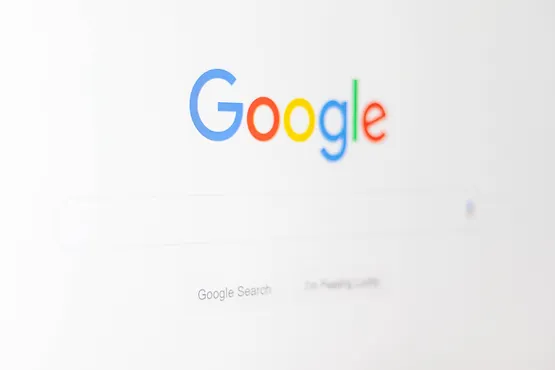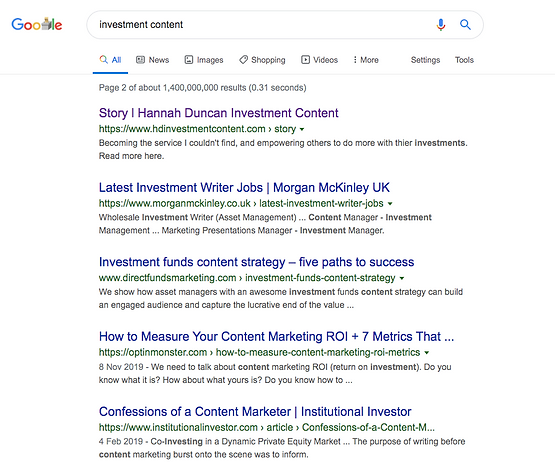Updated: Apr 7, 2020
Every day, most people will search for something on Google between three or four times[1]. In fact, every single second, the engine receives more than 63,000 search requests. With Google having over 90% of the search engine market share, SEO is a must-have for businesses.

It’s being at the top of the Google results pages
So, what is SEO? Well the best way to describe it is by thinking of yourself. How many times do you use Google every day? And what are you typing? What words are you using to find your answer? Have you noticed that different words will lead to different results? As a customer, a consumer of content, it doesn’t really matter to you which words you use. You can try again until you get your answer. Probably you don’t give it a moment’s thought.
If you flip to the other side of the coin, as a business, it’s vital. It’s the difference between getting noticed or getting ignored. Having a thriving enterprise, or crashing. Knowing exactly what words people like you are using and how popular they are is a game-changer. Nobody is scrolling past pages and pages of results to find their answer. Who does that? Do you know anyone who searches behind page 3? When I first launched my website, you could have found me on page 4 for ‘Investment Content’. Nightmare. Obviously nobody clicked on it. Figuring out what customers are typing in, and ensuring that they come up first is everything for today’s businesses. The process of getting there is called Search Engine Optimisation, or SEO.

How can copywriters use SEO?
As a copywriter, there is no getting away from it. You need to be applying the best SEO practices across your work. If you don’t, you’re relying more on luck than strategy for your work to get noticed. Luckily, there are some good tips and tricks you can use to help maximise your exposure to new potential customers.
Here are some of the best things I’ve learned about SEO for copywriters.
1. Make sure that Google can see you
Give Google permission to crawl and index your site
First things first. You would not believe the number of people who publish things on their site, which are hidden from Google. Ensure that your site indexing is switched on. Otherwise, what’s the point? You need to grant Google permission to show your pages online, it’s not automatically granted. It’s a good idea to go through your pages, and double check. If you can’t find yourself on Google, that might be why. Just look around your Content Management System and make sure that the “Indexing” box is checked with a little tick.
Taking too long…?
Once you’ve added a new page, blog or made changes to your website, you can go to Google Search Console. Paste in the link of the new page and you’ll get yourself on the waiting list to be visible on search engines.

This will speed up the process of getting your new page on the google search engine results.
2. Get a list of keywords or titles
To capture your ideal reader, you’ll need to know what your new potential customers are searching for. You’ll need an idea of how many are searching for it every month and what words they are using. There a few ways to do this.
SEO Platforms
The best way to get this information is by using an SEO platform. You’ll usually have to pay for these. It’s around £100 a month. If you can, you could save on this cost by asking your client to provide you with a list of keywords. Up to you. Moz provides quite a few tools for free, including a trial month of their all-singing, all-dancing Moz Pro platform, on the house. For copywriting, most people say that SEM Rush is the best SEO platform, as it gives you good ideas for content and titles. Personally I prefer a platform called AH Refs. There are no free trials, and it’s not at all user-friendly, but I love it. It’s like a grouchy old man, who really knows his stuff. AH Refs also has a sneaky ability to analyse your competitors, so you can check out their SEO progress too, look for gaps and see how you compare in the rankings
Free methods
If you are not flushed with cash, no worries. There are some copywriting tricks to help you get started. You could use a free platform such as Answer The Public which gives you a list of commonly typed questions. You could also start typing your words into google and see what it predicts you’ll say next. There are a bunch of other ideas out there. For example, some people have a nose around on competitor sites to see if they want to copy the keywords. I’m not a fan of this, but it’s a pretty standard practice.
For more copywriting freebies check out my blog, The (Totally Free) Copywriter’s Secret Toolkit.
3. Pick your keywords wisely
Difficulty vs Traffic
You’ll want to find the balance between keywords which’ll get you to the top of the search engine results easily, versus things most people will actually search for. It’s a competitive world out there. Most SEO platforms will rank the keywords in terms of difficulty and traffic. Difficulty means how hard it will be to get to the top of the search results page. It is ranked out of 100. Traffic means how many people are searching for your keywords. Depending on the content, I’d aim for a difficulty of 10 or less for words which have an audience of more than 20 people per month for quicker results. For more long term results, then go for it. Go for those heavy hitting key words in your page headings, and write a lot of blogs (we’ll come to that in a bit).
4. Use your keywords in headings
The most effective place for your keywords are in the headings of the text. This doesn’t mean putting something in bold. Fail. It means that you’ll need to highlight the text and ensure that it is set as a ‘H1’ or ‘H2’. It needs to be a heading according to Google. Otherwise, it’s just not worth it. Putting them into the body of the text is way less effective from a SEO perspective. This is good news for copywriters who want to wow audiences with their great vocabulary and unique content.
5. Always, always, always add alt tags to images
This is the quickest SEO win. It takes a second and makes a world of difference. Adding an alt tag to your images means that Google knows what it is. As of today, Google just can’t read an image such as a JPG or PNG. It doesn’t have eyes like us. You’ll need to tell it what’s going on. This will help boost your SEO. It’s pretty easy to do, when you’re adding your images to your site, they’ll be an option to add alt text somewhere. Dig around and you’ll find it.
As a rule of thumb, be honest. If the image is of a pencil, don’t put the alt tag as “Jenny’s best ever donuts, jam donuts, custard donuts, Jenny, Yum”. Instead put, “yellow pencil on a table, near a sheet of paper”. You can add your company name if you want – I often do – but only if I’ve taken the picture myself.
6. Make your articles interesting
I didn’t mean to sound patronising. Of course interesting and engaging articles are essential. But there is also a valid SEO strategy behind it too. If you can keep people on your page for longer, you will rise higher up the search engine results. Aim for longer or ‘complete’ articles. An article of more than 1000 words means that people will spend an average of 123 seconds on your site. (You can find this and other statistics here). With a lower bounce rate, your ranking is boosted. Add pictures, videos and social media links. Write for your audience. Create fresh, relevant content. Spend your time creating and curating something really gorgeous that everyone will love.
7. Blog. Often.
To help push along your keyword strategy, you’ll need regular updates to your website. These should be new pages which contain your keywords in the headings. A common strategy is to publish interesting blogs around your subject of expertise. Make the most of long-tail keywords and don’t be afraid of becoming too niche. Post genuinely helpful and engaging blogs at least once a week. Most strategies aim for more than two..
A note about blogging … This isn’t the place for the hard sell. Not. The. Place. Your customers won’t trust you if you keep trying to flog your product in the articles. Be genuinely helpful. Be funny, or informative, or inspiring, or whatever makes you unique. Don’t trick people into reading an advert. Reference the product, sure. But the focus is to get people visiting your site and building a relationship with your brand. It can’t be too pushy.
8. Try to get other people to link to your content on their sites
Outbound links
When another website links your webpage in their text, it boosts your ranking on the results page. This is because Google has figured out that if somebody else is trusting you and quoting you, you’re probably a good egg. They’re called ‘outbound links’ and they’re really good. Especially if it’s in the first paragraph of text. The words themselves which are hyperlinked. For example you want to be linked to “Jenny’s donuts are the best ever”.
For that matter, be a sport and add some outbound links yourself. Some people are quite against this, because they don’t want people leaving their site. They have a point. But personally I think it’s nice thing to do. As a fellow human being. You never know, they might even link you back!
The person who is linking you makes a big difference to your ranking. If you get a really good one, such as the BBC or government, it’s worth a lot more than a friend with a part-time lifestyle blog.
Inbound links
You can also add your own hyperlinks, to different parts of your website. They’re called ‘in-bound links’. It’s a good practice. It’ll help keep people moving around your site, while boosting your own SEO. Aim to have a landing page link within in the first paragraph.
9. Don’t write for SEO
Don’t be a pyscho. SEO is a great tool, but its not the be-all and end-all of copywriting. If your content is good, interesting and engaging, people will come to you. At the end of the day, it’s better to write excellent content which has little SEO value, than mediocre content which has lots of SEO. After all, if people click on your site and then instantly click away again, you’ll lose ground on the search results pages.
You can’t beat Google at its own game
Keyword stuffing is so 90s. It’s over. Cramming keywords in white text headings. Forcing words into click-baity nonsense. Gross. Google has seen it all before. And its smarter than you at SEO. The last thing you want is to be punished by Google. Use these tips to enhance your visibility, but don’t abuse them. Stay genuine and credible always.
10. It takes a little time … plan ahead for product launches
Rome wasn’t built in a day. Don’t forget that all these SEO practices take time and patience. It’ll probably take a few months for your hard work to begin to pay off. Think about this when you have a product launch ahead. Begin blogging with relevant keywords a few months in advance. Build up a kind of brand equity on google for your chosen area. This’ll help you leapfrog when the time comes. Also make sure that your PR firms are linking you left, right and centre for their press releases.
This isn’t everything … Keep researching…
Of course, this isn’t everything you’ll need as a copywriter. Keep learning about SEO. Keep practicing and you’ll pick up some valuable insights. As a starting platform, these ten tips should get you on the right track. As you do more and more copywriting for websites, you’ll see there are extra bits here and there where you can optimise text.
For example, you’ll also need to consider the little chunk of writing which describes your webpage on Google (called ‘Meta Data’ and ‘Meta Descriptions’). You’ll also have to think about the type of industry you work in. I work in finance and this sector falls into a category called ‘Your Money or Your Life’ on Google. There are some special rules to be aware of. You can find out more about how to write copy for finance here.
SEO is a great way to gain exposure. Use it and love it. But don’t become obsessed by it. You are what makes your content unique. Not the keywords. Best of luck!



